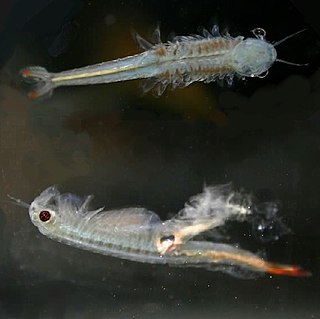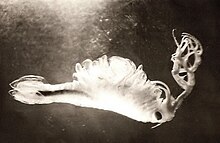
Branchiopoda is a class of crustaceans. It comprises fairy shrimp, clam shrimp, Diplostraca, Notostraca and the Devonian Lepidocaris. They are mostly small, freshwater animals that feed on plankton and detritus.

Anostraca is one of the four orders of crustaceans in the class Branchiopoda; its members are referred to as fairy shrimp. They live in vernal pools and hypersaline lakes across the world, and they have even been found in deserts, ice-covered mountain lakes, and Antarctic ice. They are usually 6–25 mm (0.24–0.98 in) long. Most species have 20 body segments, bearing 11 pairs of leaf-like phyllopodia, and the body lacks a carapace. They swim "upside-down" and feed by filtering organic particles from the water or by scraping algae from surfaces, with the exception of Branchinecta gigas, or "giant fairy shrimp", which is itself a predator of other species of anostracans. They are an important food for many birds and fish, and some are cultured and harvested for use as fish food. There are 300 species spread across 8 families.

Noctuoidea is the superfamily of noctuid or "owlet" moths, and has more than 70,000 described species, the largest number of any Lepidopteran superfamily. Its classification has not yet reached a satisfactory or stable state. Since the end of the 20th century, increasing availability of molecular phylogenetic data for this hugely successful radiation has led to several competing proposals for a taxonomic arrangement that correctly represents the relationships between the major lineages.

Branchinecta is a genus of fairy shrimp in family Branchinectidae. It includes around 50 species, found on all continents except Australia. Branchinecta gigas, the giant fairy shrimp, is the largest species in the order, with a length of up to 10 centimetres (4 in), and Branchinecta brushi lives at the highest altitude of any crustacean, at 5,930 metres (19,460 ft), a record it shares with the copepod Boeckella palustris. A new genus, Archaebranchinecta was established in 2011 for two species previously placed in Branchinecta.

Branchinella is a genus of crustaceans in the family Thamnocephalidae. This fairy shrimp genus is found across many parts of the world, but especially western Australia and southern Africa.

Chirocephalus is a genus of fairy shrimp in the family Chirocephalidae. It contains the following species:

Dexteria floridana is an extinct species of fairy shrimp in the family Chirocephalidae, the only species in the genus Dexteria. It was endemic to Florida, where it was known from a single pool, south of Gainesville. It was originally described by Ralph W. Dexter in 1953 as a species of Eubranchipus. The species was declared extinct on October 5, 2011 because it was found that the only known pool of water that contained the known population was filled in for development, thereby killing the shrimps.

Streptocephalus is a genus of fairy shrimp found in temporary waters in Africa, Australia, Eurasia, and Central and North America, following its ancient origin in Gondwana. It contains the following species:

Branchinectidae is a family in the order Anostraca, containing two genera – Branchinecta and Archaebranchinecta. The majority of the species are in the genus Branchinecta, with only Archaebranchinecta pollicifera and the fossil Archaebranchinecta barstowensis in the second genus.

Bosmina is a genus in the order Cladocera, the water fleas. Its members can be distinguished from those of Bosminopsis by the separation of the antennae; in Bosminopsis, the antennae are fused at their bases.

Branchipodidae is a family of fairy shrimp, one of eight in the order Anostraca. It contains 35 extant species in five extant genera:

Dendrocephalus is a genus of fairy shrimp found in South and North America. It is characterised by the presence of an antenna-like appendage arising between the second antennae and the eyestalks. The genus comprises 16 species in two subgenera:

Limnadiidae is a family of crustaceans in the order Spinicaudata that live in seasonal wetlands, inland saline pools and lakes. They are found on all the world's continents except Antarctica, and are distinguished from other families in the same order by the fact that the cephalic fornicies do not extend forwards. The family contains eight extant genera:

Bosminidae is a family of anomopods in the order Diplostraca. There are at least 3 genera and 40 described species in Bosminidae.

Macrothricidae is a family of anomopods in the order Diplostraca. There are about 17 genera and at least 80 described species in Macrothricidae.
Cactus is a genus of anomopods in the family Macrothricidae. There is only one described species, Cactus cactus. C. cactus can be found in Chile.

Podonidae is a family of onychopods in the order Diplostraca. There are about 8 genera and at least 20 described species in Podonidae. A lot of them are non-native species, many of which pose a great threat to aquatic ecosystems.

Evadne is a genus of onychopods in the family Podonidae. There are at least four described species in Evadne.
Lynceus is a genus of clam shrimp in the family Lynceidae. There are about 13 described species in Lynceus.
Phallocryptus spinosus, the halophilic fairy shrimp, is a species of fairy shrimp within the family Thamnocephalidae. The species of previously recorded from a shallow salty pond in Tabriz, occurring in the same area as Branchinecta orientalis. More locations were reported in similar habitats in central and south Iran from Bafq and Lar, and a 4th population was found 200 kilometers south to the original locality.

















